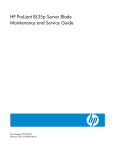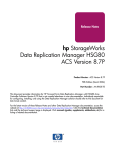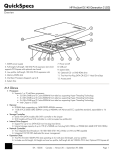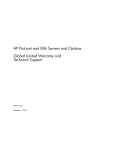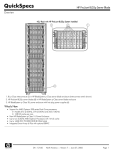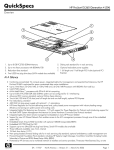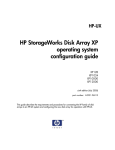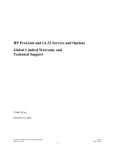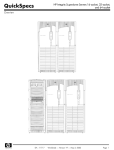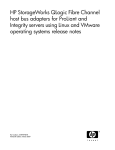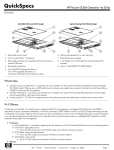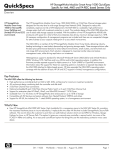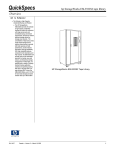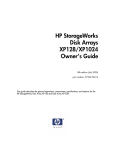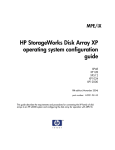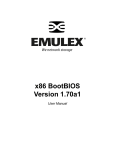Download HP XP12000 User's Manual
Transcript
HP StorageWorks Disk Array XP operating system configuration guide: Windows 2000/2003 XP12000 XP10000 SVS200 Part number: A5951-96194 Fifth edition: June 2006 Legal and notice information © Copyright 2003-2006 Hewlett-Packard Development Company, L.P. Confidential computer software. Valid license from HP required for possession, use or copying. Consistent with FAR 12.211 and 12.212, Commercial Computer Software, Computer Software Documentation, and Technical Data for Commercial Items are licensed to the U.S. Government under vendor’s standard commercial license. The information contained herein is subject to change without notice. The only warranties for HP products and services are set forth in the express warranty statements accompanying such products and services. Nothing herein should be construed as constituting an additional warranty. HP shall not be liable for technical or editorial errors or omissions contained herein. Microsoft, Windows, Windows XP, and Windows NT are U.S. registered trademarks of Microsoft Corporation. Contents Preface . . . . . . . . . . . . . . . . . . . . . . . . . . . . . . About this guide . . . . . . . . . Intended audience . . . . . . . . Disk arrays . . . . . . . . . . . Related documentation . . . . . . Document conventions and symbols HP technical support . . . . . . . Subscription service . . . . . . . Other HP web sites . . . . . . . Documentation feedback . . . . . . . . . . . . . . . . . . . . . . . . . . . . . . . . . . . . . . . . . . . . . . . . . . . . . . . . . . . . . . . . . . . . . . . . . . . . . . . . . . . . . . . . . . . . . . . . . . . . . . . . . . . . . . . . . . . . . . . . . . . . . . . . . . . . . . . . . . . . . . . . . . . . . . . . . . . . . . . . . . . . . . . . . . . . . . . . . . . . . . . . . . . . . . . . . . . . . . . . . . . . . . . . . . . . . . . . . . . . . . . . . . . . . . . . . . . . . . . . . . . . . . . . . . . . . . . . . . . . . . . . . . 1 Installation . . . . . . . . . . . . . . . . . . . . . . . . . . . . Features and requirements . . . . . . . . . . . . Fibre Channel interface . . . . . . . . . . . . Device emulation types . . . . . . . . . . . . Failover . . . . . . . . . . . . . . . . . . SNMP configuration . . . . . . . . . . . . . RAID Manager command devices . . . . . . . Installation procedures . . . . . . . . . . . . . . Install and configure the disk array . . . . . . . . . Setting the host mode and host group mode for the Setting the System Option Mode . . . . . . . . Configuring the Fibre Channel ports . . . . . . Fibre address . . . . . . . . . . . . . . Fabric and connection parameter settings . . Install and configure the host . . . . . . . . . . . Loading the OS and software . . . . . . . . . Installing and configuring the HBAs . . . . . . . Cross-referencing HBAs . . . . . . . . . . Fabric zoning and LUN security . . . . . . . . Connect the disk array . . . . . . . . . . . . . . Defining the paths . . . . . . . . . . . . . . Verifying the host recognizes array devices . . . Configure disk devices . . . . . . . . . . . . . . Writing signatures . . . . . . . . . . . . . . Creating and formatting disk partitions . . . . . Verifying file system operations . . . . . . . . . . . . . . . . . . . . . . . . disk . . . . . . . . . . . . . . . . . . . . . . . . . . . . . . . . . . . . . . . . . . . . . . . . . . . . . . . . . . . . . . . . . . . . . . . . array ports . . . . . . . . . . . . . . . . . . . . . . . . . . . . . . . . . . . . . . . . . . . . . . . . . . . . . . . . . . . . . . . . . . . . . . . . . . . . . . . . . . . . . . . . . . . . . . . . . . . . . . . . . . . . . . . . . . . . . . . . . . . . . . . . . . . . . . . . . . . . . . . . . . . . . . . . . . . . . . . . . . . . . . . . . . . . . . . . . . . . . . . . . . . . . . . . . . . . . . . . . . . . . . . . . . . . . . . . . . . . . . . . . . . . . . . . . . . . . . . . . . . . . . . . . . . . . . . . . . . . . . . . . . . . . . . . . . . . . . . . . . . . . . . . . . . . . . . . . . . . . . . . . . . . . . . . . . . . . . . . . . . . . . . . . . . . . . . . . . . . . . . . . . . . . . . . . . . . . . . . . . . . . . . . . . . . . . . . . . . . . . . . . . . . . . . . . . . . . . . . . . . . . 2 Troubleshooting . . . . . . . . . . . . . . . . . . . . . . . . . Error conditions . . . . . . Calling the HP support center Contact information . . Before you call . . . . . . . . . . . . . . . . . . . . . . . . . . . . . . . . . . . . . . . . . . . . . . . . . . . . . . . . . . . . . . . . . . . . . . . . . . . . . . . . . . . . . . . . . . . . . . . . . . . . . . . . . . . . . . . . . . . . . . . . . . . . . . . . . . . . . . . . . 5 5 5 5 5 6 7 7 7 7 9 . . 9 . 10 . 10 . 10 . 11 . 11 . 12 . 12 . 13 . 14 . 15 . 15 . 16 . 16 . 16 . 16 . 17 . 18 . 19 . 19 . 20 . 20 . 20 . 21 . 21 . . . . 23 24 25 25 25 A Path worksheet . . . . . . . . . . . . . . . . . . . . . . . . . 27 B Disk array supported emulations . . . . . . . . . . . . . . . . . . 29 Supported emulations . . . . . . . . . . . . . . . . . . . . . . . . . . . . . . . . . . . HP StorageWorks Disk Array XP operating system configuration guide: Windows 2000/2003 29 3 Emulation specifications . . . . . . . . . . . . . . . . . . . . . . . . . . . . . . . . . . 30 Glossary . . . . . . . . . . . . . . . . . . . . . . . . . . . . . 33 Index . . . . . . . . . . . . . . . . . . . . . . . . . . . . . . 37 4 Preface About this guide This guide provides information about: • Requirements and procedures for connecting an XP disk array or the SVS200 to a host system • Configuring the disk array for use with the Windows 2000/2003 operating system Intended audience This guide is intended for system administrators with knowledge of: • The host hardware • Windows 2000/2003 operating system • XP disk arrays and/or the SVS200 Disk arrays Unless • HP • HP • HP otherwise noted, the term “disk array” refers to these systems: StorageWorks XP10000 Disk Array StorageWorks XP12000 Disk Array StorageWorks 200 Storage Virtualization System Related documentation The following documents provide related information: • HP StorageWorks XP10000 Disk Array: Owner’s Guide • HP StorageWorks XP12000 Disk Array: Owner’s Guide • HP StorageWorks 200 Storage Virtualization System: Owner’s Guide You can find these documents from the Manuals page of the HP Business Support Center web site: http://www.hp.com/support/manuals In the Storage section, click Storage array systems and then select your product. HP StorageWorks Disk Array XP operating system configuration guide: Windows 2000/2003 5 Document conventions and symbols Convention Element Blue text: Document conventions and symbols Cross-reference links and e-mail addresses Blue, underlined text: http:// www.hp.com Web site addresses Italic text Text emphasis and book titles Bold text • Keys that are pressed • Text typed into a GUI element, such as a box • GUI elements that are clicked or selected, such as menu and list items, buttons, tabs, and check boxes Monospace text • • • • Monospace, italictext • Code variables • Command variables Monospace, bold text File and directory names System output Code Commands, their arguments, and argument values Emphasized monospace text WARNING! Indicates that failure to follow directions could result in bodily harm or death. CAUTION: Indicates that failure to follow directions could result in damage to equipment or data. IMPORTANT: Provides clarifying information or specific instructions. NOTE: Provides additional information. TIP: Provides helpful hints and shortcuts. 6 Preface HP technical support Telephone numbers for worldwide technical support are listed on the HP support web site: http://www.hp.com/support/. Collect the following information before calling: • • • • • • Technical support registration number (if applicable) Product serial numbers Product model names and numbers Error messages Operating system type and revision level Detailed questions For continuous quality improvement, calls may be recorded or monitored. Subscription service HP recommends that you register your product at the Subscriber’s Choice for Business web site: http://www.hp.com/go/e-updates. After registering, you will receive e-mail notification of product enhancements, new driver versions, firmware updates, and other product resources. Other HP web sites For additional information, see the following HP web sites: • • • • http://www.hp.com http://www.hp.com/go/storage http://www.hp.com/service_locator http://www.hp.com/support/manuals Documentation feedback HP welcomes your feedback. To make comments and suggestions about product documentation, please send a message to [email protected]. All submissions become the property of HP. HP StorageWorks Disk Array XP operating system configuration guide: Windows 2000/2003 7 8 Preface 1 Installation You and your HP service representative each play a role in installation. Your HP service representative is responsible for installing the disk array and formatting the disk devices. You are responsible for configuring the host server for the new devices with assistance from your HP service representative. Features and requirements Ask your HP service representative about the latest supported hardware and software. The disk array has the following features: • Storage capacity. The storage capacity for each model is listed below: XP10000: Up to 240 drives for up to 69.2 TB, 48 FC ports XP12000: Up to 1152 drives for up to 332 TB, 128 FC ports SVS200 Up to 127 TB of external storage, 48 FC ports • Server support. Windows 2000/2003 PC server with the latest HP supported patches • Operating system support. Windows 2000/2003 Before installing the disk array, ensure the environment conforms to these requirements: • Host Bus Adapters (HBAs) Install HBAs and all utilities and drivers. Refer to the adapter documentation for installation details. • (Recommended) HP StorageWorks Remote Web Console XP, Command View XP Advanced Edition or Command View XP with LUN management feature for configuring disk array ports and paths • (Recommended) HP StorageWorks LUN Configuration and Security Manager XP • (Optional) Other available XP software (some may not apply to your system): HP StorageWorks Business Copy XP HP StorageWorks Continuous Access XP HP StorageWorks Continuous Access Extension XP HP StorageWorks Continuous Access XP Journal HP StorageWorks Auto LUN XP HP StorageWorks Data Exchange XP HP StorageWorks RAID Manager XP HP StorageWorks Cache LUN XP HP StorageWorks Auto Path XP HP StorageWorks Cluster Extension XP HP StorageWorks Performance Advisor XP Software HP StorageWorks External Storage XP HP StorageWorks XP Disk/Cache Partition Software HP StorageWorks Flex Copy XP HP StorageWorks XP Data Shredder Software HP StorageWorks Performance Control XP HP StorageWorks Disk Array XP operating system configuration guide: Windows 2000/2003 9 Fibre Channel interface The XP family of disk arrays and the SVS200 support these Fibre Channel elements: • • • • Connection speeds of 1 Gbps, 2 Gbps, and 4 Gbps (XP12000/XP10000 only) Short-wave non-OFC (open fiber control) optical interface Multimode optical cables with SC or LC connectors Public or private arbitrated loop (FC-AL) or direct fabric attach Even though the interface is Fibre Channel, this guide uses the term “SCSI disk” because disk array devices are defined to the host as SCSI disks. Device emulation types The XP family of disk arrays and the SVS200 support these device emulation types: • OPEN-3/8/9/E/L/V devices: OPEN-x logical units represent disk devices. Except for OPEN-V, these devices are based on fixed sizes. OPEN-V is a user-defined size. Supported emulations include OPEN-3, OPEN-8, OPEN-9, OPEN-E, OPEN-L, and OPEN-V devices. • LUSE devices (OPEN-x*n): Logical Unit Size Expansion (LUSE) devices combine 2 to 36 OPEN-x devices to create expanded LDEVs larger than standard OPEN-3/8/9/E/L/V disk devices. For example, an OPEN-x LUSE volume created from ten OPEN-x volumes is designated as OPEN-x*10. • CVS devices (OPEN-x CVS): Volume Size Configuration (VSC) defines custom volumes (CVS) that are smaller than normal fixed-sized logical disk devices (volumes). (OPEN-V is a CVS-based custom disk size that you determine. OPEN-L does not support CVS.) • LUSE (expanded) CVS devices (OPEN-x*n CVS): LUSE CVS combines CVS devices to create an expanded device. This is done by first creating CVS custom-sized devices and then using LUSE to combine from 2 to 36 CVS devices. For example, if three OPEN-9 CVS volumes are combined to create an expanded device, this device is designated as OPEN-9*3-CVS. NOTE: For the SVS200, and the XP12000/XP10000 when connected to external storage devices, HP recommends using OPEN-V as the emulation the array makes visible to the host. This allows external storage LDEVs to be configured without losing data. Using any other emulation may cause data loss in the external storage LUNs. Failover The disk arrays support many standard software products that provide host, application, or I/O path failover and management. 10 Installation SNMP configuration The XP family of disk arrays and the SVS200 support standard Simple Network Management Protocol (SNMP) for remotely managing arrays. The SNMP agent on the service processor (SVP) performs error-reporting operations requested by the SNMP manager. SNMP properties are usually set from the SVP but they can also be set remotely using Command View (XP arrays only), Remote Web Console, or Command View XP Advanced Edition. Refer to the applicable user’s guide for procedures. RAID Manager command devices RAID Manager manages Business Copy (BC) or Continuous Access (CA) operations from a host server. To use RAID Manager you must designate at least one LDEV as a command device. This can be done with Command View (XP arrays only), Remote Web Console , or Command View XP Advanced Edition. Refer to the applicable user guide for information about how to designate a command device. HP StorageWorks Disk Array XP operating system configuration guide: Windows 2000/2003 11 Installation procedures Perform these actions to install and configure the disk array: 1. Install and configure the disk array • Setting the host mode and host group mode • Setting the System Option Mode • Configuring the Fibre Channel ports 2. Install and configure the host • Loading the OS and software • Installing and configuring the HBAs • Fabric zoning and LUN security 3. Connect the disk array • Defining the paths • Verifying the host recognizes array devices 4. Configure disk devices • Writing signatures • Creating and formatting disk partitions • Verifying file system operations Install and configure the disk array The HP service representative performs these tasks: • Assembling hardware and installing software • Loading the microcode updates • Installing and formatting devices After these tasks are finished, use Command View (XP arrays only), Remote Web Console, Command View XP Advanced Edition, or LUN Configuration and Security Manager to complete the remaining tasks listed below. If you do not have these programs, your HP service representative can perform these tasks for you. 12 Installation Setting the host mode and host group mode for the disk array ports After the disk array is installed, you must set the host mode for each disk array port to match the host OS. Set the host mode using LUN Manager in Remote Web Console (shown), Command View (XP arrays only), or Command View XP Advanced Edition. If these are not available, the HP service representative can set the host mode using the SVP. The available host mode settings for Windows 2000/2003 are as follows: Host mode Description 2C (available on some array models) HP recommended. (For use with LUSE volumes when online LUN expansion is required or may be required in the future.) 0C HP recommended. (Use if future online LUN expansion is not required or planned.) Volume on XP array (examples) Volume name as seen on host host mode = 0C host mode = 2C OPEN-E OPEN-E OPEN-E OPEN-9 OPEN-9 OPEN-9 OPEN-9*2 OPEN-9*2 OPEN-9 OPEN-9*3-CVS OPEN-9*3-CVS OPEN-9-CVS CAUTION: The correct host mode must be set for all new installations (newly connected ports) to Windows 2000/2003 hosts. Do not select a mode other than 2C and 0C for Windows 2000/2003. Changing a host mode after the host has been connected is disruptive and requires the server to be rebooted. HP StorageWorks Disk Array XP operating system configuration guide: Windows 2000/2003 13 When a new host group is added, additional host group modes (options) may be configured. The storage administrator must verify if an additional host group mode is required for the host group. The following host group modes are available for Windows 2000/2003: Host Group Mode 2 (Windows 2003 only) 6 Function Default VERITAS DBE+RAC Database Edition/Advanced Cluster for Real Application Clusters or VERITAS® Cluster Server 4.0 with I/O fencing is used. Inactive Parameter Setting Failure for TPRLO When using the Emulex HBA in the Windows environment, the parameter setting for TPRLO failed. After receiving TPRLO and FCP_CMD, respectively. PRLO will respond when HostMode=0x0C/0x2C and HostModeOption=0x06. (MAIN Ver.50-03-14-00/00 and later) Inactive Comments CAUTION: Changing host group modes for ports where servers are already installed and configured is disruptive and requires the server to be rebooted. Setting the System Option Mode The HP service representative sets the System Option Mode(s) based on the operating system and software configuration of the host. 14 Installation Configuring the Fibre Channel ports Configure the disk array Fibre Channel ports by using Remote Web Console (shown), Command View (XP arrays only), or Command View XP Advanced Edition. Select the settings for each port based on your storage area network topology. Use switch zoning if you connect different types of hosts to the array through the same switch. Fibre address In fabric environments, the port addresses are assigned automatically. In arbitrated loop environments, set the port addresses by selecting a unique arbitrated loop physical address (AL-PA) or loop ID for each port. For specific values, refer to the HP StorageWorks LUN Configuration and Security Manager XP User Guide applicable to your array. HP StorageWorks Disk Array XP operating system configuration guide: Windows 2000/2003 15 Fabric and connection parameter settings Set each array port to FABRIC ON or OFF with connections of POINT-TO-POINT or FC-AL as shown in the following table and figures. For detailed topology information, refer to the HP StorageWorks SAN Design Reference Guide on the www.hp.com website. Fabric parameter Connection parameter Provides OFF FC-AL NL-port (private arbitrated loop) ON FC-AL FL-port (public loop) for loop connection to a switch ON POINT-TO-POINT N-port (fabric port) for connection to a switch OFF POINT-TO-POINT Not supported Install and configure the host This section explains how to install and configure the host and host bus adapters (HBAs) that connect the host to the disk array. Loading the OS and software Follow the manufacturer’s instructions to load the operating system and software onto the host. Load all OS patches and configuration utilities supported by HP and the HBA manufacturer. If you purchased multipath software, install it according to the manufacturer’s instructions. Installing and configuring the HBAs Install and configure the host bus adapters using the HBA manufacturer’s instructions. HP supplies driver, firmware, and BIOS downloads for commonly available HBAs. These downloads contain HBA settings that are tested and approved by HP. To obtain a download, log onto the HP website at www.hp.com and search for the model name or number of your HBA. Download the file, and follow the installation instructions in the “readme” or documentation file supplied with each download. 16 Installation Cross-referencing HBAs The following table identifies both the HP part number and the HBA manufacturer’s number for common HBAs. HP part OEM partner OEM adapter Family (*1) KGPSA-CB Emulex LP8000 1 FCA2355 Emulex LP9002DC 1 FCA2101 Emulex LP952 1 FCA2408 / A7298A Emulex LP982 2 FCA2404 / AB232A Emulex LP9802 2 FCA2404DC Emulex LP9802DC 2 A7388A / AB467A Emulex LP1050 3 A7387A / AB466A Emulex LP1050DC 3 A7560A Emulex LP1050EX 3 None Emulex LP10000 3 FCA2142/A8002A Emulex LPe11002 6 FCA2242/A8003A Emulex LPe1150 6 FC2143 Emulex LP1150 7 FC2243 Emulex LP11002 7 FCA2214 QLogic QLA2340 4 FCA2214DC QLogic QLA2342 4 FC1142SR QLogic QLE2460 8 FC1242SR QLogic QLE2462 8 BL20p G2 (FC Mezzanine Card) BL20p G3 (FC Adapter Card) QLogic Chipset None 4 BL25p, BL45p (HPALCF 105) QLogic Chipset None 4 BL30p, BL35p (FC Balcony Card) QLogic Chipset None 4 394757–B2 (E-FC Adapter Card): BL20p G3 Emulex Chipset None 5 394588–B2 (E-FC Adapter Card): BL25p, BL30p, BL35p, BL45p Emulex Chipset None 5 Note *1: Family number shows which HBAs can use similar driver/BIOS/firmware. HP StorageWorks Disk Array XP operating system configuration guide: Windows 2000/2003 17 Fabric zoning and LUN security By using appropriate zoning and LUN security, you can connect various servers with various operating systems to the same switch and fabric: • Storage port zones may overlap if more than one operating system needs to share an array port. • Heterogeneous operating systems may share an XP array port if you use Secure Manager and set the appropriate host group and mode. All others must connect to a dedicated XP array port. • Use Secure Manager for LUN isolation when multiple hosts connect through a shared array port. Secure Manager provides LUN security by allowing you to restrict which LUNs each host can access. • QLogic and Emulex HBAs must be in separate zones (a QLogic zone and an Emulex zone) whether the HBAs are in the same or separate servers. • If booting over the SAN, within a server, the booting HBAs must be from the same vendor. Additional data storage HBAs can be from a different vendor. Environment Standalone SAN (non-clustered) Clustered SAN Multi-Cluster SAN OS mix Fabric zoning homogeneous (a single OS type present in the SAN) Not required heterogeneous (more than one OS type present in the SAN) Required LUN security Must be used when multiple hosts or cluster nodes connect through a shared port • If you plan to use clustering, install and configure the clustering software on the servers. Clustering is the organization of multiple servers into groups. Within a cluster, each server is a node. Multiple clusters compose a multi-cluster environment. The following example shows a multi-cluster environment with three clusters, each containing two nodes. The nodes share access to the disk array. 18 Installation Connect the disk array The HP representative connects the cables between the array and the host or between the array and the SAN. Defining the paths Use Remote Web Console (shown), Command View (XP arrays only), or Command View XP Advanced Edition to define paths (LUNs) between hosts and volumes in the disk array. This process is also called “LUN mapping.” In Remote Web Console and Command View, LUN mapping includes: • • • • • Configuring ports Enabling LUN security on the ports Creating host groups Assigning host bus adapter WWNs to host groups Mapping volumes to host groups (by assigning LUNs In Command View XP Advanced Edition, LUN mapping includes: • Configuring ports • Creating storage groups • Mapping volumes and WWN/host access permissions to the storage groups For details see the LUN Configuration and Security Manager User’s Guide or Command View XP Advanced Edition Device Manager Web Client User’s Guide. Note the LUNS and their ports, WWNs, nicknames, and LDEVs for later use in verifying host and device configuration. NOTE: A LUN assigned a number greater than FF is outside the accepted range of numbers for a Windows server (00 to FE) and will not be recognized by the server or be visible for use. Windows 2003: To see LUNs, you must create a LUN 0 when using the SCSIPort Miniport Driver. This is not necessary if using the StorPort Miniport Driver. Windows 2000: A LUN 0 must be created to discover more than LUNs 0 to 7. HP StorageWorks Disk Array XP operating system configuration guide: Windows 2000/2003 19 Verifying the host recognizes array devices 1. Log into the host as an administrator. 2. Right-click the My Computer desktop icon, and click Manage. 3. Click Device Manager. 4. Click SCSI and RAID Controllers. 5. Click the host bus adapter to open it, and verify all devices are displayed. 6. Click each device, click Properties, and then click Settings. 7. Record the device information on the worksheet in Appendix A. Configure disk devices Disk arrays are configured using the same procedure for configuring any new disk on the host. This includes the following procedures: • Writing signatures • Creating and formatting disk partitions • Verifying file system operations Writing signatures 1. Right-click on the My Computer desktop icon and click Manage. 2. Click Disk Management. A message notifies you that disks have been added. 3. Click OK to update the system configuration and start the Write Signature wizard, which allows you to write signatures to the disks. 4. For each new disk, click OK to write a signature, or click No to prevent writing a signature. 5. When you have performed this process for all new disks, the Disk Management main window opens and displays the added disks. 20 Installation Creating and formatting disk partitions Dynamic Disk is supported with no restrictions for a disk array connected to a Windows 2000/ 2003 system. Refer to Microsoft’s online help for details. CAUTION: Do not partition or create a file system on a device that will be used as a raw device (for example, some database applications use raw devices.) 1. In the Disk Management main window, select the unallocated area for the SCSI disk you want to partition. 2. Click the Action menu, and click Create Partition to launch the New Partition Wizard. Follow the Partition Wizard to create and format partitions and assign drive letters. Format partitions with the following settings and format options. File System: NTFS (enables Windows to write to the disk). Allocation unit size: “Default.” Do not change this entry. Volume label: Enter a volume label, or leave this field blank for no label. Format Options: Click Perform a Quick Format to decrease the time required to format the partition. Click Enable file and folder compression only if you want to enable compression. 3. Verify the Disk Management main window displays the correct file system (NTFS) for the formatted partition. The word “Healthy” indicates that the partition has been created and formatted successfully. 4. Repeat this procedure for each new disk device. 5. Exit Disk Management, clicking Yes to save your changes. Verifying file system operations 1. Open My Computer and check that the new disks are present. 2. Right-click each disk to view Properties and verify the properties are correct (label, type, capacity, and file system). 3. Copy a file from an existing drive to each new drive to verify the new drives are working, and then delete the copies. HP StorageWorks Disk Array XP operating system configuration guide: Windows 2000/2003 21 22 Installation 2 Troubleshooting This section includes resolutions for various error conditions you may encounter. If you are unable to resolve an error condition, ask your HP support representative for assistance. See Calling the HP support center. HP StorageWorks Disk Array XP operating system configuration guide: Windows 2000/2003 23 Error conditions Depending on your system configuration, you may be able to view error messages (R-SIMS) as follows: • In Remote Web Console XP (Status tab) • In Command View XP Advanced Edition (“Alerts” panel). • In Command View XP (Event History or Event Notification panels) (XP arrays only) Error condition Recommended action The logical devices are not recognized by the host. Verify that the READY indicator lights on the disk array are ON. Verify that fiber cables are correctly installed and firmly connected. Verify that the target IDs are properly configured. The LUNs for each TID must start at 0 and continue sequentially without skipping any numbers. Verify that the TIDs/WWNs on each bus are unique. Do not install two devices with the same ID on the same bus. Recheck the buses for new devices. Verify that LUSE devices are not intermixed with normal LUNs on the same port. Verify that the maximum number of LUSE devices per port has not been exceeded. Verify that the disk array host mode is set correctly. The host does not reboot properly after hard shutdown. If you power off the host without executing the shutdown process, wait three minutes to allow the disk array’s internal timeout process to purge queued commands. If the host restarts while the disk array is processing queued commands, the host may not reboot successfully. Physical volumes cannot be created. Verify that the disk array logical devices are correctly formatted. Logical volumes cannot be created. Verify that the volume capacity for OPEN-x volumes is not greater than the maximum capacity allowed. See the Device Emulations Appendix. Verify that the capacity of the volume group is not less than the total capacity of the partitioned logical volume. A file system is not mounted after rebooting. Verify that the host was restarted correctly. Verify that the file system attributes are correct. The disk array performs a self reboot because the disk array was busy or it logged a panic message. Reboot the host. The disk array responds “Not Ready” or the disk array has displayed “Not Ready” and timed out. Contact HP. The host detects a parity error. Check the HBA and make sure it was installed properly. Reboot the host. The host hangs or devices are declared and the host hangs. Make sure there are no duplicate disk array TIDs and that disk array TIDs do not conflict with any host TIDs. 24 Troubleshooting Calling the HP support center If you are unable to resolve an error condition, contact the HP support center for assistance. Contact information Telephone numbers for worldwide technical support are listed on the HP support web site: http://www.hp.com/support/. Before you call Be sure to have the following information available: • • • • • • Technical support registration number (if applicable) Product serial numbers Product model names and numbers Applicable error messages Operating system type and revision level Detailed, specific questions For continuous quality improvement, calls may be recorded or monitored. HP StorageWorks Disk Array XP operating system configuration guide: Windows 2000/2003 25 26 Troubleshooting A Path worksheet LDEV (CU:LDEV) (CU = control unit) Device Type SCSI Bus Number Path 1 Alternate Paths 0:00 TID: LUN: TID: LUN: TID: LUN: 0:01 TID: LUN: TID: LUN: TID: LUN: 0:02 TID: LUN: TID: LUN: TID: LUN: 0:03 TID: LUN: TID: LUN: TID: LUN: 0:04 TID: LUN: TID: LUN: TID: LUN: 0:05 TID: LUN: TID: LUN: TID: LUN: 0:06 TID: LUN: TID: LUN: TID: LUN: 0:07 TID: LUN: TID: LUN: TID: LUN: 0:08 TID: LUN: TID: LUN: TID: LUN: 0:09 TID: LUN: TID: LUN: TID: LUN: 0:10 TID: LUN: TID: LUN: TID: LUN: 0:11 TID: LUN: TID: LUN: TID: LUN: 0:12 TID: LUN: TID: LUN: TID: LUN: 0:13 TID: LUN: TID: LUN: TID: LUN: 0:13 TID: LUN: TID: LUN: TID: LUN: 0:14 TID: LUN: TID: LUN: TID: LUN: 0:15 TID: LUN: TID: LUN: TID: LUN: 0:16 TID: LUN: TID: LUN: TID: LUN: 0:17 TID: LUN: TID: LUN: TID: LUN: HP StorageWorks Disk Array XP operating system configuration guide: Windows 2000/2003 27 28 Path worksheet B Disk array supported emulations This appendix provides information about supported emulations and emulation specifications. Some parameters may not be relevant to your array. Consult your HP representative for information about supported configurations for your system. Supported emulations Emulation Emulation supported LUSE CVS LUSE & CVS OPEN-3 Yes Yes Yes Yes OPEN-8 Yes Yes Yes Yes XP10000 OPEN-9 Yes Yes Yes Yes XP12000 OPEN-E Yes Yes Yes Yes SVS200 OPEN-K Yes Yes Yes Yes XP model OPEN-L OPEN-M OPEN-V NOTE: For the SVS200, and the XP12000/XP10000 when connected to external storage devices, HP recommends using OPEN-V as the emulation the array makes visible to the host. This allows external storage LDEVs to be configured without losing data. Using any other emulation may cause data loss in the external storage LUNs. HP StorageWorks Disk Array XP operating system configuration guide: Windows 2000/2003 29 Emulation specifications Emulation (Note 1) Category (Note 2) Blocks (512 bytes ) Sector Size (bytes) # of Cylinders Heads Sectors per track Capacity MB* (Note 3) OPEN-3 SCSI disk 4806720 512 3338 15 96 2347 OPEN-8 SCSI disk 14351040 512 9966 15 96 7007 OPEN-9 SCSI disk 14423040 512 10016 15 96 7042 OPEN-E SCSI disk 28452960 512 19759 15 96 13893 OPEN-L SCSI disk 71192160 512 49439 15 96 34761 OPEN-V SCSI disk max=125827200 512 Note 5 15 128 Note 6 OPEN-3*n SCSI disk 4806720*n 512 3338*n 15 96 2347*n OPEN-8*n SCSI disk 14351040*n 512 9966*n 15 96 7007*n OPEN-9*n SCSI disk 14423040*n 512 10016*n 15 96 7042*n OPEN-E*n SCSI disk 28452960*n 512 19759*n 15 96 13893*n OPEN-L*n SCSI disk 71192160*n 512 49439*n 15 96 34761*n OPEN-V*n SCSI disk max=125827200 Note 4 512 Note 5 15 128 Note 6 OPEN-3 CVS SCSI disk Note 4 512 Note 5 15 96 Note 6 OPEN-8 CVS SCSI disk Note 4 512 Note 5 15 96 Note 6 OPEN-9 CVS SCSI disk Note 4 512 Note 5 15 96 Note 6 OPEN-E CVS SCSI disk Note 4 512 Note 5 15 96 Note 6 OPEN-3*n CVS SCSI disk Note 4 512 Note 5 15 96 Note 6 OPEN-8*n CVS SCSI disk Note 4 512 Note 5 15 96 Note 6 OPEN-9*n CVS SCSI disk Note 4 512 Note 5 15 96 Note 6 OPEN-E*n CVS SCSI disk Note 4 512 Note 5 15 96 Note 6 OPEN-V*n SCSI disk Note 4 512 Note 5 15 128 Note 6 LUSE CVS CVS LUSE *Capacity = (512 x number of blocks) ÷ 10242 Note 1: The availability of an emulation depends on the disk array. Note 2: The devices are defined to the host as SCSI disk devices, even though the interface is Fibre Channel. Note 3: The device capacity can sometimes be changed by the BIOS or host adapter board. This may make actual capacity different from that listed in the table. 30 Disk array supported emulations Note 4: The number of blocks for a CVS volume is calculated as follows: # of blocks = (# of cylinders) × (# of heads) × (# of sectors per track) Example For an OPEN-3 CVS volume with capacity = 37 MB: # of blocks = (53 cylinders–see Note 5) × (15 heads) × (96 sectors per track) = 76320 Example For an OPEN-V CVS volume with capacity = 49 MB: # of blocks = (53 cylinders–see Note 5) × (15 heads) × (128 sectors per track) = 101760 Note 5: The number of cylinders for a CVS volume is calculated as follows (↑…↑ means that the value should be rounded up to the next integer): OPEN-3/8/9/E: The number of cylinders for a CVS volume = # of cylinders = ↑ (capacity (MB) specified by user) × 1024/720 ↑ Example For an OPEN-3 CVS volume with capacity = 37 MB: # of cylinders = ↑37 × 1024/720↑ = ↑52.62↑ (rounded up to next integer) = 53 cylinders OPEN-V: The number of cylinders for a CVS volume = # of cylinders = ↑ (capacity (MB) specified by user) × 16/15 ↑ Example For an OPEN-V CVS volume with capacity = 49 MB: # of cylinders = ↑49 × 16/15↑ = ↑52.26↑ (rounded up to next integer) = 53 cylinders OPEN-3/8/9/E: The number of cylinders for a CVS LUSE volume = # of cylinders = ↑ (capacity (MB) specified by user) × 1024/720 ↑ × n Example For a CVS LUSE volume with capacity = 37 MB and n = 4: # of cylinders = ↑37 × 1024/720↑ × 4 = ↑52.62↑× 4 = 53 × 4 = 212 OPEN-V: The number of cylinders for a CVS LUSE volume = # of cylinders = ↑ (capacity (MB) specified by user) × 16/15 ↑ × n Example For an OPEN-V CVS LUSE volume with capacity = 49 MB and n = 4: # of cylinders = ↑49 × 16/15↑ × 4 = ↑52.26↑× 4 = 53 × 4 = 212 Note 6: The capacity of an OPEN-3/8/9/E CVS volume is specified in MB, not number of cylinders. The capacity of an OPEN-V CVS volume can be specified in MB or number of cylinders. You set the volume size using Remote Web Console, Command View (XP arrays only), or Command View XP Advanced Edition. HP StorageWorks Disk Array XP operating system configuration guide: Windows 2000/2003 31 32 Disk array supported emulations Glossary AL Arbitrated loop. AL-PA Arbitrated loop physical address. array group A group of 4 or 8 physical hard disk drives (HDDs) installed in an XP disk array and assigned a common RAID level. RAID1 array groups consist of 4 (2D+2D) or 8 HDDs (4D+4D). RAID5 array groups include a parity disk but also consist of 4 (3D+1P) or 8 HDDs (7D+1P). All RAID6 array groups are made up of 8 HDDs (6D+2P). BC HP StorageWorks Business Copy XP. BC lets you maintain up to nine local copies of logical volumes on the disk array. CA HP StorageWorks Continuous Access XP. CA lets you create and maintain duplicate copies of local logical volumes on a remote disk array. Command View (CVXP) HP StorageWorks Command View XP, a software product for managing XP arrays. Command View runs on a Windows-based management workstation. Command View XP Advanced Edition (CVXP AE) HP StorageWorks Command View XP Advanced Edition, installs on the user-provided Device Manager server and provides a browser-based platform from which you can manage the SVS200 and the XP family of disk arrays—even globally distributed arrays. command device A volume on the disk array that accepts Continuous Access or Business Copy control operations which are then executed by the disk array. CU Control Unit. Contains LDEVs and is approximately equivalent to SCSI Target ID. CVS Custom volume size. CVS devices (OPEN-x CVS) are custom volumes configured using array management software to be smaller than normal fixed-size OPEN system volumes. Synonymous with volume size customization (VSC). DKC The array cabinet that houses the channel adapters and service processor (SVP). DKU (disk cabinet unit) The array cabinets that house the disk array physical disks. emulation modes The logical devices (LDEVs) associated with each RAID group are assigned an emulation mode that makes them operate like OPEN system disk drives. The emulation mode determines the size of an LDEV: OPEN-3: 2.46 GB OPEN-8: 7.38 GB OPEN-9: 7.42 GB OPEN-E: 13.56 GB OPEN-L: 36 GB OPEN-V: User-defined custom size failover Disconnecting a failed unit or path and replacing it with an alternative unit or path in order to continue functioning. FC Fibre Channel. FC-AL Fibre Channel arbitrated loop. FCP Fibre Channel Protocol. GB Gigabytes. HP StorageWorks Disk Array XP operating system configuration guide: Windows 2000/2003 33 HBA Host bus adapter. host mode Each port can be configured for a particular host type. These modes are represented as two-digit hexadecimal numbers. For example, host mode 08 represents an HP-UX host. LDEV Logical device. An LDEV is created when a RAID group is carved into pieces according to the selected host emulation mode (that is, OPEN-3, OPEN-8, OPEN-L). The number of resulting LDEVs depends on the selected emulation mode. The term LDEV is often used synonymously with the term volume. LUN Logical unit number. A LUN results from mapping a SCSI logical unit number, port ID, and LDEV ID to a RAID group. The size of the LUN is determined by the emulation mode of the LDEV and the number of LDEVs associated with the LUN. For example, a LUN associated with two OPEN-3 LDEVs has a size of 4,693 MB. LUSE A LUN is normally associated with only a single LDEV. The LUSE feature allows a LUN to be associated with 1 to 36 LDEVs. Essentially, LUSE makes it possible for applications to access a single large pool of storage. The LUSE feature is available when the HP StorageWorks LUN Configuration and Security Manager product is installed. OFC Open Fibre Control. OPEN-x A general term describing any one of the supported OPEN emulation modes (for example, OPEN-L). OS Operating system. PA Physical address. path “Path” and “LUN” are synonymous. Paths are created by associating a port, a target, and a LUN ID with one or more LDEVs. port A physical connection that allows data to pass between a host and the disk array. The number of ports on an XP disk array depends on the number of supported I/O slots and the number of ports available per I/O adapter. The XP family of disk arrays supports Fibre Channel (FC) ports as well as other port types. Ports are named by port group and port letter, such as CL1-A. CL1 is the group, and A is the port letter. RAID Redundant array of independent disks. remote console PC The PC running HP StorageWorks Remote Control XP. Remote Control (RC) HP StorageWorks Remote Control XP. A software product used for managing XP arrays. Remote Web Console (RWC) HP StorageWorks XP Remote Web Console. A browser-based program installed on the SVP that allows you to configure and manage the disk array. R-SIM Remote service information message. SCSI Small computer system interface. SIM Service information message. SNMP Simple Network Management Protocol. SVP Service processor, which is the PC built into the disk controller. The SVP provides a direct interface into the disk array. SVP use is reserved for HP support representatives only. SVS Storage Virtualization System, an appliance that manages multiple disk array storage systems. 34 Glossary TB Terabyte. TID Target ID. Volume On the XP array, a volume is a uniquely identified virtual storage device composed of a control unit (CU) component and a logical device (LDEV) component separated by a colon. For example 00:00 and 01:00 are two uniquely identified volumes; one is identified as CU = 00 and LDEV = 00, and the other as CU = 01 and LDEV = 00; they are two unique separate virtual storage devices within the XP array. VSC Volume size customization. Synonymous with CVS. WWN World Wide Name. A unique identifier assigned to a Fibre Channel device. HP StorageWorks Disk Array XP operating system configuration guide: Windows 2000/2003 35 36 Glossary Index A AL-PA, 15 arbitrated-loop physical address, 15 audience, 5 Auto LUN XP, 9 Auto Path XP, 9 documentation HP web site, 5 providing feedback, 7 E B Business Copy XP, 9, 11 emulation(s) supported, 30 error conditions, 24 External Storage XP, 9 C F Cache LUN XP, 9 Cluster Extension XP, 9 command device(s) RAID Manager, 11 Command View, 9, 11, 15, 19 Command View XP Advanced Edition, 9, 11, 15, 19 configuration Fibre Channel ports, 15 host mode, setting, 13 port, 15 configure devices, 20 Continuous Access Extension XP, 9 Continuous Access XP, 9, 11 Continuous Access XP Journal, 9 conventions document, 6 text symbols, 6 D Data Exchange XP, 9 device(s) configuring, 20 logical, not recognized by host, 24 type specifications, 30 types supported, 10 disk array(s) connecting, 19 installation, 12 Not Ready error message, 24 self reboots, 24 disk partitions create, 21 format, 21 document conventions, 6 related documentation, 5 fabric topology settings, 16 failover, 10 Fibre Channel interface, 10 Fibre Channel adapters, configuring, 16 file system(s) not mounted after rebooting, 24 verify operations, 21 Flex Copy XP, 9 G glossary, 33 H help obtaining, 7 host doesn’t reboot properly, 24 hangs up, 24 Host Bus adapter configuring, 17 host mode, setting, 13 HP technical support, 7 I installation disk array, 12 interface Fibre Channel, 10 L LDEV(s) designate at least one as a command device, 11 HP StorageWorks Disk Array XP operating system configuration guide: Windows 2000/2003 37 logical volumes, cannot be created, 24 LUN Configuration and Security Manager XP, 9, 19 LUN(s) creating, 19 mapping, 19 software, optional, 9 Subscriber’s Choice, HP, 7 symbols in text, 6 system option mode, 14 O technical support HP, 7, 25 service locator web site, 7 text symbols, 6 troubleshooting error conditions, 24 technical support, 25 optional software, 9 P parity error, 24 path(s) defining, 19 worksheet, 27 Performance Advisor XP Software, 9 Performance Control XP, 9 physical volumes, cannot be created, 24 port(s) Fibre Channel, 15 host mode, setting, 13 R RAID Manager command devices, 11 RAID Manager XP, 9 related documentation, 5 Remote Web Console, 9, 11, 15, 19 S SNMP configuration, 11 38 T V volume(s) logical, cannot be created, 24 physical, cannot be created, 24 W web sites HP , 7 HP Subscriber’s Choice for Business, 7 product manuals, 5 worksheet, path, 27 X XP Data Shredder SW, 9 XP Disk/Cache Partition SW, 9







































